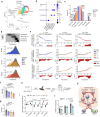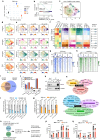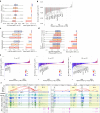Loss of CREBBP and KMT2D cooperate to accelerate lymphomagenesis and shape the lymphoma immune microenvironment
- PMID: 38570506
- PMCID: PMC10991284
- DOI: 10.1038/s41467-024-47012-1
Loss of CREBBP and KMT2D cooperate to accelerate lymphomagenesis and shape the lymphoma immune microenvironment
Abstract
Despite regulating overlapping gene enhancers and pathways, CREBBP and KMT2D mutations recurrently co-occur in germinal center (GC) B cell-derived lymphomas, suggesting potential oncogenic cooperation. Herein, we report that combined haploinsufficiency of Crebbp and Kmt2d induces a more severe mouse lymphoma phenotype (vs either allele alone) and unexpectedly confers an immune evasive microenvironment manifesting as CD8+ T-cell exhaustion and reduced infiltration. This is linked to profound repression of immune synapse genes that mediate crosstalk with T-cells, resulting in aberrant GC B cell fate decisions. From the epigenetic perspective, we observe interaction and mutually dependent binding and function of CREBBP and KMT2D on chromatin. Their combined deficiency preferentially impairs activation of immune synapse-responsive super-enhancers, pointing to a particular dependency for both co-activators at these specialized regulatory elements. Together, our data provide an example where chromatin modifier mutations cooperatively shape and induce an immune-evasive microenvironment to facilitate lymphomagenesis.
© 2024. The Author(s).
Conflict of interest statement
A.M.M. has research funding from Janssen, Epizyme and Daiichi Sankyo. A.M.M. has consulted for Exo Therapeutics, Treeline Biosciences, Astra Zeneca, Epizyme. C.S. has performed consultancy for Seattle Genetics, AbbVie, and Bayer and has received research funding from Bristol Myers Squibb, Epizyme and Trillium Therapeutics Inc. D.W.S. has received honoria from Abbvie, AstraZeneca, Incyte and Janssen and research funding from Janssen and Roche. C.E.M. is a cofounder and board member for Biotia and Onegevity Health as well as an advisor or grantee for Abbvie, ArcBio, Daiichi Sankyo, DNA Genotek, Tempus Labs, and Whole Biome. O.W. has research funding from Incyte and serves in the advisory board of BeiGene. T.J.P. has provided consultation for AstraZeneca, Chrysalis Biomedical Advisors, Merck, and SAGA Diagnostics (compensated); and receives research support (institutional) from AstraZeneca and Roche/Genentech. T.J.P. is an inventor on patents of the CapIG-seq and CapTCR-seq methods held by the University Health Network. R.Z. is inventor on patent applications related to work on GITR, PD-1 and CTLA-4. R.Z. is scientific advisory board member of iTEOS Therapeutics, and receives grant support from AstraZeneca and Bristol Myers Squibb. The remaining authors declare no competing interests.
Figures








Update of
-
Cooperative super-enhancer inactivation caused by heterozygous loss of CREBBP and KMT2D skews B cell fate decisions and yields T cell-depleted lymphomas.bioRxiv [Preprint]. 2023 Feb 13:2023.02.13.528351. doi: 10.1101/2023.02.13.528351. bioRxiv. 2023. Update in: Nat Commun. 2024 Apr 3;15(1):2879. doi: 10.1038/s41467-024-47012-1. PMID: 36824887 Free PMC article. Updated. Preprint.
References
MeSH terms
Substances
Grants and funding
LinkOut - more resources
Full Text Sources
Molecular Biology Databases
Research Materials
Miscellaneous

